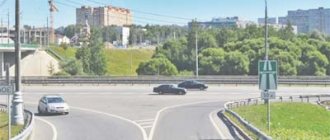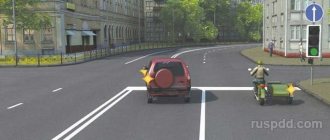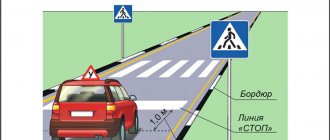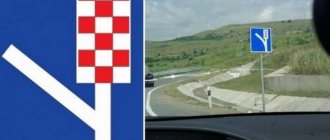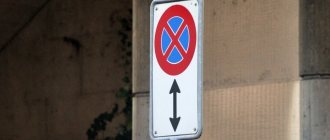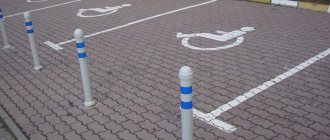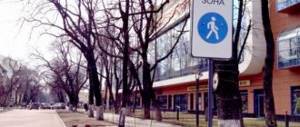In this topic, we will figure out why this sign was invented, what role it plays in traffic rules, because without knowing the basics of traffic rules, you can find yourself in an awkward situation, which will ultimately lead to an accident on the road.
Dear readers! Our articles talk about typical ways to resolve legal issues, but each case is unique. If you want to find out how to solve your particular problem, please use the online consultant form on the right or call. It's fast and free!
What does the road narrowing sign mean and what does it look like?
Road narrowing belongs to the category of warning signs and is installed:
- In the city, according to traffic rules, it is installed at a distance of approximately 100 meters from the beginning of the site
- Outside the city on the highway at a distance of an average of 200 meters.
- Outside the populated area, it is re-installed 50 meters before the dangerous area.
Even people who graduated from driving school a long time ago and may have forgotten some traffic rules will understand it. After all, there is nothing complicated in its structure. The sign itself looks like a triangle with a red border and signals a decrease in the number of lanes and the need to change lanes.
If a road sign has an unusual yellow background, this means it is temporarily in this place and is installed in places where road work is being carried out. But there are times when the one established in this place and the temporary one contradict each other. In this situation, you should be guided by temporary signs.
Types of road narrowing sign
It has three different types:
- 1.20.1 - the road narrows both on the right and on the left;
- 1.20.2 - the road narrows on the right;
- 1.20.3 - the road narrows on the left.
They all look almost the same.
Signs warn the driver that one of the lanes will soon end and there is a need to change lanes. Usually the sign is also accompanied by markings on the road, but if there are none, you should pay more attention to the signs.
1.20.1 - narrowing of the road on both sides is much less common than 1.20.1 and 1.20.2. It happens that a three-lane road turns into a one-lane one. In this case, you need to be even more careful, because cars change lanes on both the right and left into one lane, and you will need to know who is giving way to whom when changing lanes.
Rules for such a maneuver
The procedure for simultaneous and single changes of cars from row to row is regulated by paragraph 8.4 of the traffic rules.
It contains the following requirements.
- If a car is driving in the right lane and wants to continue driving in the left lane, the driver must make sure that his maneuver is safe and turn on the appropriate turn direction indicator light. Moreover, if another car is driving on the left (interference on the left), then it has priority. It follows from this that the obstacle on the left must be passed forward, and only after that, after making sure it is safe, carry out the above maneuver.
- If a car is moving in the left lane and wants to change lanes (make a maneuver) to the right lane, then the driver must turn on the turn signal and make sure that there is no obstacle on the right (another vehicle), and then move. In this case, the car that is driving in the other lane (obstacle on the right) has the advantage, so you need to let it pass, and then just carry out the maneuver.
Such rules are established so that you can safely change lanes. This is not a difficult maneuver, but it requires maximum attention from the driver and the choice of a certain speed limit.
In addition, drivers must carefully monitor the road situation and choose the optimal speed limit. That is, even if someone violates traffic rules and creates an emergency situation, they should try to avoid an accident by correct maneuvering.
Cases when you may encounter this sign
Situations on the road are different. This sign can be found:
- in the city
- outside the populated area.
But it is quite difficult to find it in the city; it is usually replaced by road markings.
So, the main cases when you may encounter this sign:
- The sign is found in those places where one of the stripes ceases to exist. And it’s good if you know this section of the road and can change into the desired lane in advance, but for drivers who drive here for the first time, narrowing the road can cause a lot of trouble in the city. For example, you are driving through the city and see a narrowing road in front of you. You are faced with the need to change lanes, but there is a dense flow of cars in the adjacent lane, which does not give you room to maneuver. And you have to either slow down too much, or stop completely and wait until they let you pass or there is enough distance between the cars so that you can change lanes. But don't forget to turn on your turn signals when changing lanes.
- This sign can also be found at road work sites. As we said, its difference is the yellow background of the sign. In this case, the lane on the road is simply fenced off by road workers and it becomes temporarily inaccessible for traffic.
- The sign is installed in places where you exit from a minor road onto a wide highway or avenue.
- The sign can also be found before passing under a bridge, where the road usually narrows from several lanes in one direction to one lane.
Situations where there is no warning sign
There are also situations when there is no sign and the road narrows. What to do in this case? It's quite simple. You must follow other travel rules.
Considering that your lane is ending, when changing lanes you must give way to other cars moving without changing direction.
This is stated in rule 8.4, because when you change lanes into an adjacent lane, you will be an obstacle for other cars. And don't forget to turn on your turn signals to give advance warning of your maneuver.
Features of the “Give Way” family signs
Like most other warning signs, signs indicating a narrowing of the roadway are triangular in shape with a white background and a wide red border around the perimeter. Inside the sign there are pictograms of two stripes. If the taper is on both sides, both stripes will be curved with a taper at the top. With a one-sided reduction, one of the stripes will be straight, and it will be located on the side where the narrowing is not expected. This designation is intuitive and means that if you are driving from a straight lane, you have the right of way because you are moving straight.
If the road narrows on the left side, this means that traffic moving along it will have to change lanes to the adjacent right lane, and vice versa. If a two-way narrowing is expected, both the left and right columns will have to change lanes to the central lane.
In any case, those drivers who are driving in the lane to which they need to change lanes have an advantage. In most cases, the interpretation of this family of signs does not cause ambiguous interpretation.
Varieties of the “Narrowing Road” sign
Who must yield when approaching a narrowing road sign?
- According to traffic rules, the driver must give way to passing traffic. But it happens that the flow is too dense and there is practically no opportunity to change lanes into it. Usually, drivers have their own rules. Seeing that your road is narrowing, they may let you into the stream. But there are also situations at an intersection where not everyone is ready to yield, and in this case, be patient and wait, but remember for the future to change lanes in advance. Don’t forget that you don’t need to blatantly move into another lane, interfering with other road users, because you are not only breaking traffic rules by not giving way, but you can also get into an accident in which you are found guilty.
- When changing lanes from the right and left lanes at the same time, it is necessary to use the “right hand” rule, and in this case, the one with interference on the right must yield. Those. If you change lanes from the left lane and at the same time another car changes lanes from the right, then it is an obstacle for you on the right, according to this rule, it must pass first, and you give way to it. And vice versa, when you are trying to change lanes from the right lane, and at the same time a car is driving from the left lane, then you have the advantage. But do not forget that not all drivers can do this. For example, a young driver who has just graduated from a driving school may get confused on the road, or a very arrogant motorist for whom the rules are not written, in this situation it is better to give in to them so as not to end up in an emergency.
Always remember that compliance with traffic rules is the key to your safety. Never forget to look at the signs, because they are installed for a reason, but to warn drivers about a possible danger or situation on the road. And if you ignore them, you can get into an accident or find yourself in an incomprehensible situation on the road.
Didn't find the answer to your question? Find out how to solve exactly your problem - call right now: +7 (Moscow) +7 (812) 309-53-42 (St. Petersburg) It's fast and free!
Free online consultation with a car lawyer
Didn't find the answer to your question? Find out how to solve exactly your problem - call right now: +7 (Moscow) +7 (812) 309-53-42 (St. Petersburg) It's fast and free!
Priority when the road narrows
Pajero mini
The sign is triangular in shape with a red border, inside which there are two lines. The narrowing will be indicated by a curve, depending on which band is changing.
The designation is intuitive. A bit of banality: the narrowing on the right is indicated as follows: on the left side the stripe is straight, and on the right side it is curved, and vice versa. If there is a narrowing on the left, then drivers should change lanes to the right. If there is a narrowing on both sides, then you need to change lanes to the central lane.
Many people are concerned about the question of who should give in when narrowing. If the road ahead narrows and vehicles are traveling in two rows, then those who do not need to change traffic go first.
If the driver needs to change lanes, he must wait until the cars that do not need to maneuver pass. Drivers driving in a lane that does not change maintain a distance to change lanes for vehicles from another lane. This allows you to change lanes without problems and not create an emergency situation.
If the route where the sign is installed is overloaded, or a traffic jam has formed, then it is necessary to follow the rules of road ethics. Drivers will definitely let you into the next row. You can express your gratitude by pressing the emergency lights.
Motorists often drive along a highway where there is no warning or markings.
IMPORTANT! You must follow the rules, just like if you have a sign. Failure to comply with traffic rules may result in administrative penalties.
During the trial, the fact that there are no warning signs is taken into account, however, even in this case, drivers who change lanes must give way to those moving in another lane and not changing direction.
You will find some more information on this issue in the video:
Bottom line
When changing the road, you need to remember the traffic rules, as amendments and changes are periodically made. Safe driving means following the rules of all motorists. When changing lanes, remember to maintain the optimal distance and some other points that we just talked about.
- Next It has become tougher: the punishment for leaving the scene of an accident has been changed
- Back KIA Soul 2019-2020: start of sales in Russia, configurations and prices
- Taxes and fines / Reference information
Aug 27, 2019
- Ratings / Comparison of crossovers
Aug 26, 2019
- Aug 26, 2019
- Engine/Ratings
Aug 23, 2019
- Hyundai crossovers / News
Aug 23, 2019
- Aug 22, 2019
- April 13, 2019
- March 12, 2019
- Feb 17, 2019
- April 11, 2019
- July 27, 2017
Popular crossovers
Acura crossovers Audi crossovers BMW crossovers Cadillac crossovers Chevrolet crossovers Chery crossovers Citroen crossovers Dodge crossovers Ford crossovers Honda crossovers Infiniti crossovers Jeep crossovers Hyundai crossovers Kia crossovers Lexus crossovers Lada crossovers Land Rover crossovers Mazda crossovers Mercedes crossovers Mini crossovers Mitsubishi crossovers Nissan crossovers Porshe crossovers Peugeot crossovers Crossovers Opel Crossovers Renault Crossovers Ssang Yong Crossovers Skoda Crossovers Subaru Crossovers Suzuki Crossovers Toyota Crossovers Volkswagen Crossovers Volvo Crossovers
Signs “Narrowing of the road”: how to correctly interpret who has priority
- Varieties of sign
- Tapering options
- Lack of signs and markings
Hi all! The issue of traffic rules has not been discussed for a long time. And then an unpleasant traffic situation arose, which prompted the idea to talk about the Narrowing of the road sign.
Many have seen it, but not everyone knows how to act correctly in a given situation. Moreover, we are talking specifically about a red triangular sign. There is also blue, which is often confused with narrowing. In fact, a similar blue sign means the end of the strip. If anyone is interested, we will discuss it in our separate article.
Today we focus on the signs of the 1.20 series. Let's try to find out how to pass on the left or right, who should give way and how to act if narrowing occurs on both sides.

